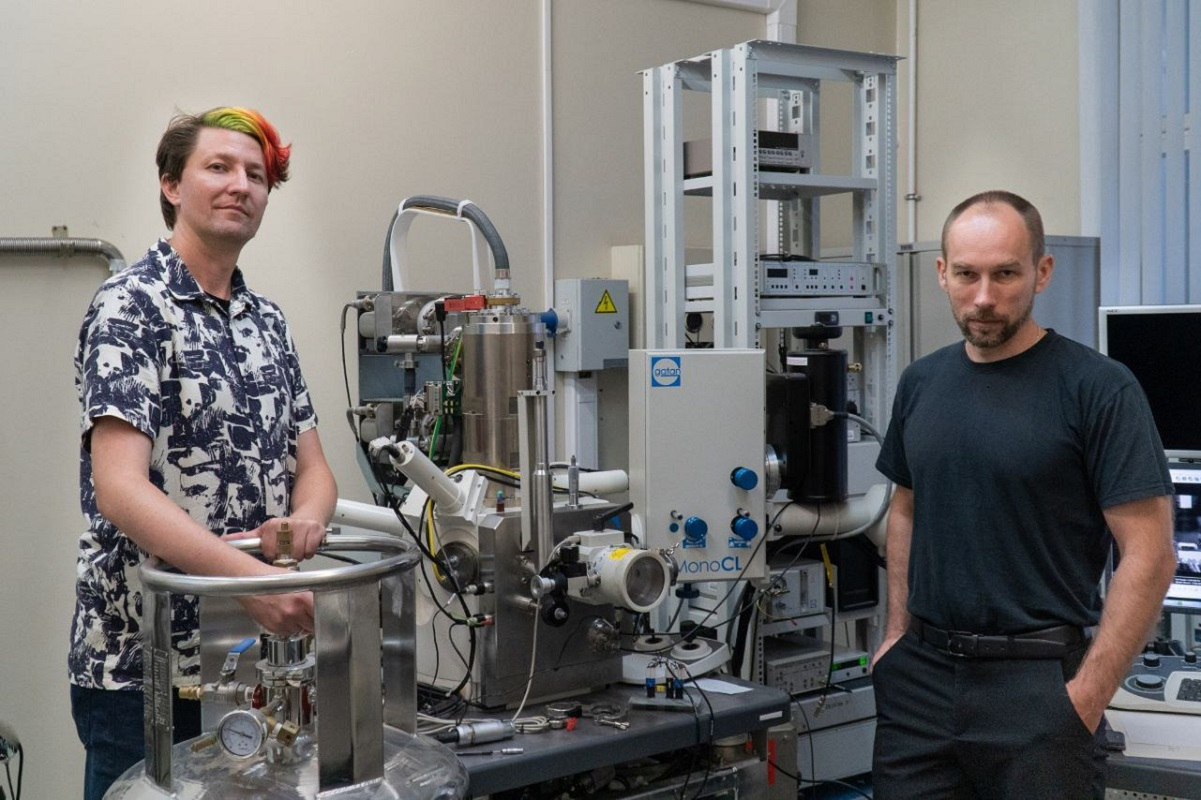Physicists from St Petersburg University study the luminescence of a promising perovskite semiconductor
Scientists from St Petersburg University have identified the nature of the luminescence produced by electron beam irradiation of the halide perovskite semiconductor MAPbCl₃. The perovskite was synthesised at the Laboratory of Crystal Photonics at St Petersburg University, established under the mega-grant programme of the Ministry of Science and Higher Education of the Russian Federation.

The familiar white light of LED bulbs is achieved by applying a yellow-orange phosphor to a tiny semiconductor crystal that emits ultraviolet or blue light. Thus, the "heart" of any LED bulb is a semiconductor.
The research findings are published in The Journal of Physical Chemistry Letters.
They are typically expensive to produce because they require pure starting materials and high temperatures. Around ten years ago, researchers began exploring new semiconductors — halide perovskites. These perovskite crystals are much cheaper to produce than their "classical" counterparts, as they are grown from solution.
One such halide perovskite is MAPbCl₃, a hybrid compound of chlorine, lead, and a small organic methylammonium cation. Crystals of this perovskite are transparent and emit a blue and near-ultraviolet glow when excited.
To study wide-bandgap semiconductors, the crystal under investigation is irradiated with a beam of electrons in an electron microscope equipped with an optical spectrometer. The energy from the incident electrons excites the crystal, causing it to glow — this is known as luminescence.
Semiconductors luminesce at room temperature, but cooling the crystal to low temperatures provides deeper insights into the processes occurring within the crystal and the mechanisms behind its luminescence. The scientists from the Laboratory of Crystal Photonics at St Petersburg University synthesised a crystal of MAPbCl₃ and studied its cathodoluminescence at the temperature of liquid nitrogen (-196°C).
The luminescence spectrum of the halide perovskite MAPbCl₃ is complex, consisting of three main spectral bands. While these bands have been observed before, their origins and dependencies were not understood. Our study has now clarified these mechanisms.
Yury Kapitonov, Associate Professor at St Petersburg University
One of the spectral bands was identified as the luminescence of foreign impurities on the crystal surface, while the other two are intrinsic to the perovskite itself. The scientists determined that one of these bands corresponds to the glow of excitons — "artificial atoms" that exist in semiconductors— while the other is associated with defects in the crystal. As the researchers noted, semiconductors with defects do not usually luminesce, so significant effort is required to produce luminescent crystals of sufficient purity and quality. However, defects in halide perovskites have the unique ability to emit a bright blue glow. Previously, experts from the laboratory were the first in the world to measure the dispersion of the refractive index of the perovskite MAPbI₃ at the temperature of liquid helium.
Previously, experts from the laboratory were the first in the world to measure the dispersion of the refractive index of the perovskite MAPbI₃ at the temperature of liquid helium.
"Our unexpected finding was the ability to rearrange the luminescence colour when the sample is irradiated with electrons. The luminescence colour can change without any reduction in intensity, indicating that the defect structure of the halide perovskite rearranges into a stable form. This type of rearrangement could be utilised to fine-tune finished products made of halide perovskite, such as LEDs," explained Yuri Petrov, Associate Professor of St Petersburg University.
The research was carried out at the Laboratory of Crystal Photonics at St Petersburg University, established under the mega-grant programme of the Ministry of Science and Higher Education of the Russian Federation. The researchers also used the equipment of the Nanophotonics Resource Centre of the St Petersburg University Research Park.
St Petersburg University, the oldest university in Russia, was founded on 28 January (8 February) 1724. This is the day when Peter the Great issued a decree establishing the University and the Russian Academy of Sciences. Today, St Petersburg University is an internationally recognised centre for education, research and culture. In 2024, St Petersburg University celebrates its 300th anniversary.
The plan of events during the celebration of the anniversary of the University was approved at the meeting of the Organising Committee for the celebration of St Petersburg University’s 300th anniversary. The meeting was chaired by Dmitry Chernyshenko, Deputy Prime Minister of the Russian Federation. Among the events are: the naming of a minor planet in honour of St Petersburg University; the issuance of bank cards with a special design; and the branding of the aircraft of the Rossiya Airlines to name just a few. To mark the 300th anniversary of St Petersburg University, a postage stamp depicting the Twelve Collegia building and the monument to Count Sergey Uvarov was issued. Also, a Soyuz rocket bearing the symbols of the University was launched from the Baikonur Cosmodrome.
By the decision of the Governor of St Petersburg Alexander Beglov, 2024 is a year of the 300th anniversary of St Petersburg University in St Petersburg. On the day of the University’s 300th anniversary torches were lit on the Rostral Columns on the Spit of Vasilyevsky Island. St Petersburg University flags were raised on the Palace Bridge. The city public transport was decorated with the University’s symbols. During St Petersburg’s City Day celebrations in May 2024, St Petersburg University acted as a participating venue. Additionally, the University has launched a website dedicated to the anniversary. The website contains information about outstanding University staff, students, and alumni; scientific achievements; and details of events held as part of the celebration of the 300th anniversary of the University.

